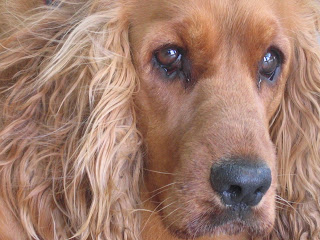After taking Ivy to her vet, it seems she has Feline Hyperesthesia Syndrome also known as "rolling skin syndrome," and is in some ways very similar to a seizure disorder. It appears to be more common in Siamese cats, but other cases have been reported. FHS usually appears between the ages of 1-4. Unfortunately, there is very little known about this disorder, and information is difficult to find.
Symptoms of FHS:
Dilated pupils
Twitching of the tail
Appearing to be annoyed with the tail
Biting at the tip of the tail, sometimes to the point of mutilation
Behavior may change from loving, to scared and depressed
Sensitive to touch around the tail
Staring into space
Persistent, loud meowing
Dashing off madly and aimlessly around the house or yard
Rippling skin on the back just above the tail
Seizures
These symptoms are not always triggered by unpleasant events, but can occur while you are petting your cat loving, or when touching your cat near the tail.
It is difficult to make conclusions as to why this disorder occurs, but it is believed by some that over-vaccinating, flea infestations, OCB, food allergy, low quality diets, preservatives and chemicals may be leading to this problem.
The vet took a blood test from which we will get the results this week to
rule out other health problems such as Thyroid, Diabetes, Cancer, Liver or Kidney disease. A health problem may be triggering these episodes.
We have switched her to either all chicken with some seafood diet of better canned brands like Wellness, Pet Guard, Innova etc. Sometimes it is a food allergy. Beef is a prime culprit in food allergies in this situation. My vet has seen dogs go into seizures from eating a rawhide beef bone.
Research has shown that a low quality diet -- meaning a diet loaded with chemicals, fillers, stabilizers, coloring agents, sodium nitrate (found to produce epileptic-like changes in the brain activity of rats who ate it regularly) and by-products -- can lead to allergies, nervousness, hypertension, diabetes, weight problems, dry skin, and many other common ailments.
Because of what goes into pet foods today and what does not, it is important to know how to read labels, and know the history of the company manufacturing the pet food.
Some pets suffer from hypoglycemia, which is a medical term meaning low blood sugar. The causes of hypoglycemia are overproduction of insulin, excessive exercise, heredity, or an inadequate diet. Some symptoms of hypoglycemia are very similar to Feline Hyperesthesia Syndrome.
Symptoms of a hypoglycemic attack are:
Staggering, collapse or dashing around
Weakness
Aggression
Moodiness
Glassy eyes, dilated pupils
Seizure
Because the symptoms of hypoglycemia and FHS tend to be similar, feeding structured meals is suggested. When you feed one meal a day, your pet's body produces insulin. High levels of insulin cause low levels of fat burning and high levels of fat storing, the reverse of what you may think. When insulin is not stable in the body, it throws the hormones and brain chemicals out of whack and the body starts storing fat to save itself.
Therefore, it is extremely important to feed 3~4 times a day. When you feed several small meals a day, the body burns fat more effectively, and speeds up the metabolism so your pet can burn more calories.
Ivy had fleas in spite of using flea control products so my vet asked me to use Capstar and Revolution on Ivy and all the cats in the house. Plus I have been vacuuming daily. This seems to be helping a great deal. Ivy has had only one seizure since the vet visit. I have two other cats who have severe skin issues due to flea allergies and they too have cleared up since using Capstar and Revolution.
I am also treating Ivy with a calming herbal extract with Skullcap, St. John's Wort, Calendula, Chamomile, California Poppy, Oat, Valerian two to three times a day in milk.
Homeopathic remedies Phosphorus and Belladonna also help the seizure activity lessen.
This illness is a trial and error process to find the right combination of things that keep the seizures and behavior in check. Some animals can live with minor episodes and have no other issues. I am hoping we can get Ivy to that point and soon.




































